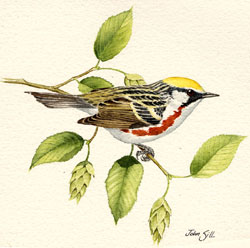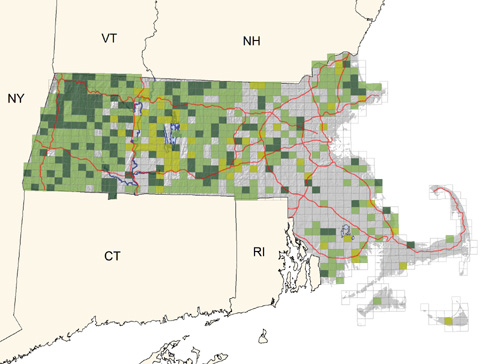Find a Bird - BBA1
Breeding Bird Atlas 1 Species Accounts
Chestnut-sided Warbler
Dendroica pensylvanica
Egg Dates
May 22 to July 19
Number of Broods
one or two

The Chestnut-sided Warbler is an excellent example of a species that has prospered because of human influence on the environment. Because it requires forest edge and regions of secondary growth for nesting, it was rare in the heavy forests that covered much of Massachusetts before European settlement. The birds benefited as large areas of forest were cut because of the increase in edge. With the decline of agriculture and subsequent abandonment of farmland beginning in the late nineteenth century, the species rapidly became a common breeder as widespread acreage began to revert to forest.
The heyday of the Chestnut-sided Warbler is past. As the Massachusetts forests matured during the twentieth century, the population of this warbler declined, particularly in eastern portions of the state. It is still common today through western and central Massachusetts and eastward to Essex County, but it seems a certainty that these numbers will be severely reduced in the future.
Breeding habitats are areas of secondary growth, shrubs, and a dense understory of herbaceous plants. The most attractive sites are old, abandoned fields and pastures, where patches of trees intermix with stands of saplings and clumps of briers and other low-growing plants. Other favorable locales are woodland clearings, brook and roadside borders, and power-line cuts. Territories generally include portions of the surrounding mature forest as well as brushy areas.
Most residents arrive during the first week of May, although some return later, and a few appear during the last days of April. Because the breeding grounds extend north to southern Canada, migrants continue to pass through during May. The males are highly territorial, and, because the species is so common, the claiming of an area usually involves extensive periods of singing interspersed with chases and fights. This time-consuming activity continues throughout the breeding season.
Males have two basic types of songs, both of which are variable. The first is characterized by a distinctive, accented end note and is represented as chee, chee, chee, chee, swee, beat, you, while the second is a more rambling song without the accented ending, i.e., chew, chew, chew, chew, chee, chee, chitchee, witchee. The two song types are apparently used in different contexts. Males also have definite favored song perches. These are typically elevated and exposed; and, if a dead snag or bare branch is available, it will almost certainly be used. Courtship usually includes chases, and the male often follows the female, hopping about in his characteristic manner with wings drooped and tail slightly cocked. Both sexes have the typical warbler chip and seet notes. In addition, the young give a series of chip notes as a begging call.
Nests, constructed by the females, are composed of coarse grass, plant fibers, bark strips, and spider webs and have a lining of fine grass, rootlets, or hair. These are placed in a low bush, sapling, brier, or other herbaceous plant from 1 to 6 feet above the ground, with 2 feet being the average height. In eastern Massachusetts, nests have been found from 14 inches to 3 feet high in hazelnut and also in huckleberry, blackberry, Hardhack, and saplings (ACB). Worcester County nests have been located in blackberry and other brambles (6 nests), low bushes in old fields or wood borders (4 nests), and spiraea (1 nest). The earliest of these nests was under construction on May 13 and the last on July 3.
Four eggs are usually produced, but there may be three or five. Clutch sizes for 9 state nests were three eggs (4 nests), four eggs (5 nests) (DKW). The female incubates for 10 to 12 days, and the young remain in the nest for 9 to 12 days, during which time they are cared for by both parents. By the end of June, most of the first-brood young have fledged. They continue to be fed for the next several weeks as they gradually attain independence. Two broods are commonly reared, and during early July the female builds a second nest and produces a second clutch. Although she may continue to feed her first-brood young during this time, once she begins incubation the male takes over their care. It is not uncommon for males to feed both these older young and a new set of nestlings. During this time, there are often an intensification of song and increased boundary disputes among the males. Nestlings have been observed in the state from June 14 to August 3. A Charlton nest contained four large young on July 2. Three known fledging dates are June 27, July 3, and July 26. Fledged dependent young were recorded here from June 18 to August 26.
Intensive studies of color-banded individuals in Worcester County revealed that many birds formed monogamous pairs, but there were also some interesting discoveries. On a number of occasions, adults were observed feeding fledglings that were not their own. In one case, a female nesting in a zone where the territories of two mated males overlapped succeeded in fledging two young. In spite of intense aggressive interactions, neither male was able to exclude the other from this area, and each was observed attending this female at various times in addition to his own mate. It was impossible to determine if one or both were paired to this extra bird. Both of the resident females responded aggressively toward her.
By mid-August, many young are attaining winter plumage and are dispersing, and the adults are in a complete molt, some still tending late fledglings. From early August onward, individuals join the mixed flocks of Black-capped Chickadees and warblers that occur in this season. Chestnut-sided Warblers are characteristic members of these flocks and accompany them into deep woods as well as more open situations.
Most of the resident birds leave at the end of August and the first week of September; migrants continue to be observed until the end of September. The wintering range is in Central America from Guatemala to Panama.
Map Legend and Data Summary
Atlas 1 data collected from 1975-1979


Note: fairly common in second-growth and deciduous woodland edges; scarcer in southeastern region
W. Roger Meservey



